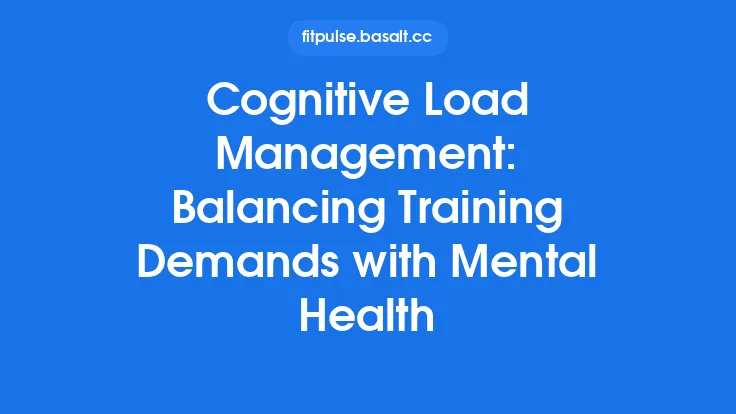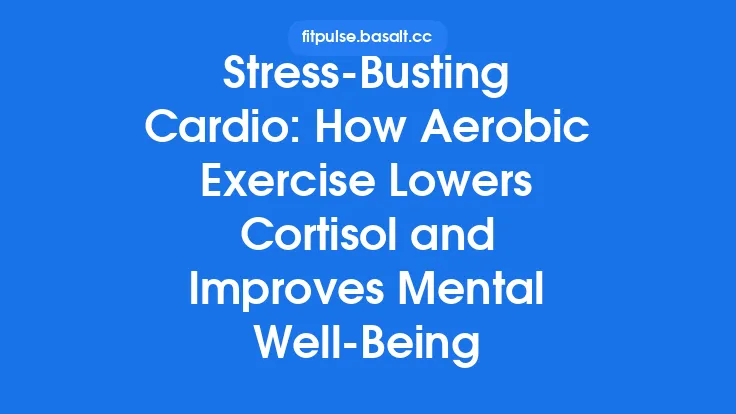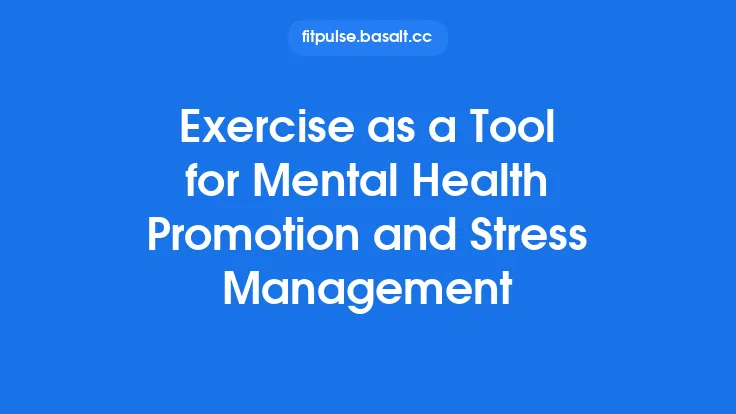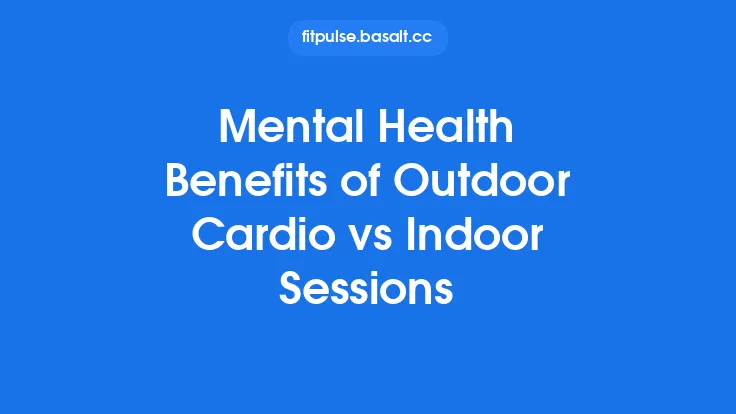Depression is a pervasive mental‑health condition that affects millions of people worldwide, influencing mood, cognition, motivation, and physical health. While pharmacological and psychotherapeutic interventions remain cornerstones of treatment, a growing body of evidence demonstrates that regular physical activity can serve as a powerful adjunctive strategy. Exercise not only mitigates depressive symptoms but also improves overall quality of life, sleep, and neurocognitive function. Understanding how to balance exercise with the unique challenges posed by depression is essential for clinicians, fitness professionals, and individuals seeking a holistic approach to mental‑health management.
Understanding Depression and Its Interaction with Exercise
Depression is characterized by persistent low mood, anhedonia (loss of pleasure), fatigue, and a range of somatic symptoms such as changes in appetite and sleep. Neurobiologically, it involves dysregulation of neurotransmitters (serotonin, norepinephrine, dopamine), altered hypothalamic‑pituitary‑adrenal (HPA) axis activity, and inflammatory processes. These changes can diminish motivation and energy, creating a feedback loop that discourages engagement in physical activity.
Exercise, in contrast, exerts acute and chronic effects that counter many of these pathophysiological alterations:
- Neurotransmitter modulation – Acute bouts increase synaptic availability of serotonin, dopamine, and norepinephrine, mirroring the action of many antidepressants.
- Neurotrophic support – Repeated exercise elevates brain‑derived neurotrophic factor (BDNF), promoting neurogenesis and synaptic plasticity, particularly in the hippocampus, a region often compromised in depression.
- HPA‑axis regulation – Regular moderate‑intensity activity normalizes cortisol rhythms, reducing chronic stress exposure.
- Anti‑inflammatory response – Exercise induces an anti‑inflammatory cytokine profile (e.g., IL‑10) and reduces pro‑inflammatory markers (e.g., IL‑6, TNF‑α) implicated in depressive pathology.
These mechanisms provide a biological rationale for incorporating exercise into depression treatment plans.
Physiological Mechanisms Linking Exercise to Mood
| Mechanism | How It Works | Evidence Summary |
|---|---|---|
| Endorphin release | Exercise stimulates the pituitary to release β‑endorphins, producing analgesic and euphoric effects. | Acute mood elevation observed after 20–30 min of moderate aerobic activity. |
| Monoamine turnover | Physical activity increases synthesis and release of serotonin, dopamine, and norepinephrine. | Comparable to selective serotonin reuptake inhibitors (SSRIs) in short‑term trials. |
| Neurogenesis | Upregulation of BDNF supports growth of new neurons, especially in the dentate gyrus. | Chronic aerobic training (≥12 weeks) linked to increased BDNF levels and reduced depressive scores. |
| Stress buffering | Regular exercise improves autonomic balance (↑ parasympathetic tone, ↓ sympathetic overactivity). | Lower resting heart‑rate variability correlates with reduced depressive symptomatology. |
| Psychosocial factors | Mastery, self‑efficacy, and social interaction during group activities enhance self‑esteem. | Meta‑analyses show greater effect sizes for supervised or group‑based programs. |
Understanding these pathways helps practitioners explain to clients why exercise can be a “medicine” for the brain, fostering adherence.
Types of Exercise Beneficial for Depression
Research consistently supports three primary modalities, each offering distinct advantages:
- Aerobic Exercise
Examples: brisk walking, jogging, cycling, swimming (non‑aquatic), dancing.
Dose: 30 minutes per session, 3–5 days per week, at 50–70 % of heart‑rate reserve (HRR) or a perceived exertion of 11–13 on the Borg scale.
Rationale: Improves cardiovascular fitness, stimulates endorphin release, and enhances BDNF.
- Resistance Training
Examples: body‑weight circuits, free‑weight exercises, resistance‑band routines.
Dose: 2–3 sessions per week, 2–3 sets of 8–12 repetitions for major muscle groups, at 60–70 % of one‑repetition maximum (1‑RM).
Rationale: Increases muscular strength, which can counteract fatigue and improve functional independence; also elevates mood via hormonal responses (e.g., growth hormone).
- Mind‑Body Practices
Examples: yoga, tai chi, Pilates, qigong.
Dose: 2–3 sessions per week, 45–60 minutes, focusing on controlled breathing and gentle movement.
Rationale: Combines low‑intensity physical activity with mindfulness, reducing rumination and anxiety often comorbid with depression.
A mixed‑modal approach—alternating aerobic, resistance, and mind‑body sessions—tends to yield the most robust improvements in depressive symptoms while minimizing monotony.
Designing an Exercise Program for Individuals with Depression
1. Initial Assessment
- Medical clearance – Verify absence of contraindications (e.g., uncontrolled hypertension, recent cardiac events).
- Psychological screening – Use validated tools (PHQ‑9, Beck Depression Inventory) to gauge severity and track progress.
- Functional baseline – Conduct a submaximal fitness test (e.g., 6‑minute walk, sit‑to‑stand) to establish starting intensity.
2. Goal Setting
- SMART goals – Specific, Measurable, Achievable, Relevant, Time‑bound.
- Example: “Walk briskly for 20 minutes, three times per week, for the next four weeks.”
- Emphasize process goals (e.g., consistency) over outcome goals (e.g., weight loss) to reduce pressure.
3. Program Structure
- Frequency – Begin with 2–3 sessions per week; gradually increase to 4–5 as tolerance improves.
- Intensity – Use the Talk Test or Rate of Perceived Exertion (RPE) to keep intensity moderate.
- Time – Start with 10–15 minute bouts, building to 30–45 minutes.
- Type – Rotate modalities to address both cardiovascular and musculoskeletal health while maintaining engagement.
4. Progression Strategies
- Incremental load – Add 5 % to duration or intensity every 1–2 weeks, depending on perceived effort and mood response.
- Variety – Introduce new activities (e.g., trail walking, circuit training) to prevent habituation.
- Self‑monitoring – Encourage use of journals or mobile apps to log sessions, mood ratings, and perceived exertion.
5. Integration with Treatment
- Coordinate with mental‑health providers to align exercise timing with medication schedules (e.g., avoid high‑intensity sessions when side‑effects like dizziness are prominent).
- Consider “exercise as a scheduled therapeutic appointment” to reinforce routine.
Monitoring Progress and Adjusting the Plan
| Metric | Tool | Frequency | Interpretation |
|---|---|---|---|
| Depressive symptoms | PHQ‑9, BDI‑II | Every 4–6 weeks | ≥5‑point reduction indicates clinically meaningful improvement. |
| Fitness level | 6‑minute walk, hand‑grip dynamometer | Baseline, 8 weeks, 16 weeks | Increases reflect improved aerobic capacity and muscular strength. |
| Sleep quality | Pittsburgh Sleep Quality Index (PSQI) | Monthly | Better scores often accompany mood improvements. |
| Adherence | Attendance logs, wearable step counts | Ongoing | ≥70 % session attendance correlates with symptom reduction. |
| Side‑effects/Adverse events | Self‑report questionnaire | Each session | Promptly address any emergent issues (e.g., joint pain, excessive fatigue). |
If depressive scores plateau or worsen, consider:
- Reducing session intensity or duration temporarily.
- Adding a mind‑body component to address anxiety.
- Re‑evaluating medication side‑effects that may impair exercise tolerance.
- Consulting a mental‑health professional for possible therapeutic adjustments.
Overcoming Barriers and Enhancing Adherence
Motivational Barriers
- Solution: Use motivational interviewing techniques—explore ambivalence, highlight personal values, and set incremental goals.
Energy/Fatigue
- Solution: Schedule workouts during times of peak energy (often mid‑morning). Begin with low‑intensity “warm‑up” activities to gradually raise arousal.
Negative Thought Patterns
- Solution: Incorporate cognitive‑behavioral strategies—challenge catastrophic thoughts (“I’ll fail”) with evidence (“I completed a 10‑minute walk yesterday”).
Social Isolation
- Solution: Encourage participation in small, supportive groups or virtual classes. Peer accountability can boost commitment.
Environmental Constraints
- Solution: Provide home‑based options (e.g., body‑weight circuits, indoor walking routes) and suggest minimal equipment (resistance bands, a sturdy chair).
Medication Side‑Effects
- Solution: Adjust timing of exercise relative to medication dosing; for sedating agents, schedule activity after the medication’s peak effect has worn off.
Integrating Exercise with Other Therapeutic Modalities
- Psychotherapy – Combine exercise with cognitive‑behavioral therapy (CBT) by using activity scheduling as a behavioral activation tool.
- Pharmacotherapy – Monitor for potential interactions (e.g., SSRIs may increase bleeding risk with high‑intensity resistance training; adjust load accordingly).
- Nutritional Support – Encourage balanced meals rich in omega‑3 fatty acids, B‑vitamins, and antioxidants to support neurochemical health.
- Sleep Hygiene – Align exercise timing to avoid late‑night vigorous activity that could disrupt sleep onset.
A multidisciplinary approach maximizes synergistic benefits, fostering a comprehensive recovery environment.
Safety Considerations and Contraindications
While exercise is generally safe for most individuals with depression, certain precautions are warranted:
- Cardiovascular Screening – Use the American College of Sports Medicine (ACSM) pre‑participation questionnaire to identify hidden risk factors.
- Medication‑Related Risks –
- Beta‑blockers: May blunt heart‑rate response; rely on RPE for intensity monitoring.
- Antidepressants with serotonergic activity: Rarely increase risk of hyponatremia; ensure adequate hydration.
- Psychiatric Stability – For clients with severe suicidal ideation, ensure close clinical supervision and crisis‑intervention plans before initiating independent exercise.
- Orthopedic Concerns – Conduct a brief musculoskeletal screen to rule out acute injuries that could be exacerbated by activity.
- Heat Sensitivity – Some antidepressants impair thermoregulation; advise moderate ambient temperatures and adequate fluid intake.
When any red flag emerges, pause the program, reassess, and consult the appropriate healthcare professional.
Practical Tips for Practitioners and Clients
- Start Small – “Micro‑workouts” of 5–10 minutes can be less intimidating and still produce mood benefits.
- Use Technology Wisely – Wearables can provide objective feedback, but avoid over‑reliance on numbers that may trigger perfectionism.
- Celebrate Non‑Performance Wins – Acknowledge attendance, effort, and mood improvements even if performance metrics lag.
- Create a “Recovery Toolkit” – Include breathing exercises, stretching routines, and a list of supportive contacts for days when motivation wanes.
- Educate on the “Exercise‑Mood Lag” – Explain that mood benefits may be most noticeable 24–48 hours after a session, encouraging persistence.
- Tailor Communication – Use empathetic language; avoid “pushy” directives that could exacerbate feelings of failure.
Future Directions and Research Gaps
- Dose‑Response Clarification – While moderate intensity is widely recommended, the optimal frequency and duration for different depression severities remain to be fine‑tuned.
- Neuroimaging Correlates – Longitudinal fMRI studies could elucidate how specific exercise regimens remodel brain networks implicated in mood regulation.
- Personalized Exercise Prescription – Integration of genetic markers (e.g., BDNF Val66Met polymorphism) may predict individual responsiveness to aerobic vs. resistance training.
- Digital Interventions – Evaluating the efficacy of app‑guided, home‑based programs versus in‑person supervision for diverse socioeconomic groups.
- Comorbidity Considerations – More research is needed on how concurrent anxiety disorders, substance use, or chronic pain influence exercise adherence and outcomes in depressed populations.
Continued interdisciplinary collaboration among exercise scientists, clinicians, and mental‑health researchers will be essential to refine evidence‑based guidelines and expand access to exercise as a therapeutic modality.
In summary, balancing exercise with mental‑health management in individuals with depression requires a nuanced, person‑centered approach that respects the fluctuating nature of mood, energy, and motivation. By grounding program design in physiological mechanisms, employing flexible progression strategies, and integrating exercise with broader therapeutic frameworks, practitioners can empower clients to harness the mood‑enhancing power of physical activity while safeguarding safety and fostering long‑term adherence. The result is not merely a reduction in depressive symptoms, but a sustainable lifestyle shift that supports overall well‑being.





